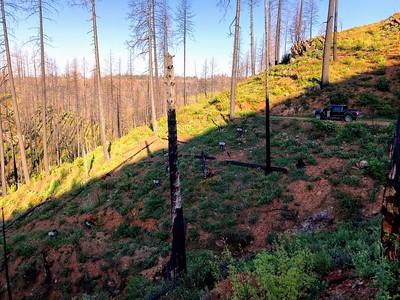The BLM partners with American Forests to develop Camp Fire Reforestation Plan
Organization:
BLM Office:
Media Contact:
SACRAMENTO, Calif. – In advancing the Department of the Interior’s commitment to bolster adaption and increase resilience to climate change, the Bureau of Land Management today released its Camp Fire Reforestation Plan. The plan, developed by the BLM and American Forests, outlines management goals, assesses potential climate impacts to the Camp Fire burn scar, and uses adaptation strategies and approaches to promote forest recovery.
The Camp Fire Reforestation Plan will improve forest health and resilience, enabling ecosystems to better withstand environmental stressors and recover from disturbances; reduce hazardous fuels and increase community safety; improve wildlife habitat and riparian/wetland functionality; improve plant community diversity and forest structural diversity; identify feasible, cost-effective strategies and plans that can be maintained long term; and protect soils by reducing sedimentation, preventing erosion and promoting a vegetation community that will stabilize soils.
“When it comes to reforestation, we have to use all the climate-smart tools in the toolbox,” said American Forests California State Director Britta Dyer. “To do so, land managers need to be willing to work across jurisdictions and look at a fire scar for what it truly is, a shared responsibility. The BLM had the foresight to be inclusive in that this plan not only restores BLM lands, but it has downstream benefits to all impacted by the devastating Camp Fire.”
“This plan will assist foresters who are implementing recovery actions to the burn scar, such as tree planting and managing vegetation,” said BLM California State Forester Coreen Francis. “The BLM and American Forests engaged stakeholders from private industry, the community, research scientists, and other agencies in developing the plan and formulating the suite of actions needed for long-term forest recovery.”
The 2018 Camp Fire burned more than 153,000 acres, killed 85 people and destroyed more than 18,000 structures in Butte County, California. Approximately 4,070 acres of BLM managed lands burned during the fire, and 36 percent of this area (1,400 acres) burned at high severity.
The BLM is at the forefront of developing adaptation strategies to climate change, and this climate planning process will help guide forest management into the future. American Forests is a national conservation organization established in 1875 to work with partners to build healthy and resilient forests in urban and rural landscapes.
The plan was written to be used by agencies, private landowners, or other entities that may be facing similar questions about how to adapt and increase resilience to climate change. A copy of the Camp Fire Reforestation Plan can be found at https://www.blm.gov/programs/natural-resources/forests-and-woodlands, or https://www.americanforests.org/wp-content/uploads/2021/09/BLM_CampPlan.pdf.
The BLM manages about 245 million acres of public land located primarily in 12 western states, including Alaska, on behalf of the American people. The BLM also administers 700 million acres of sub-surface mineral estate throughout the nation. Our mission is to sustain the health, diversity, and productivity of America’s public lands for the use and enjoyment of present and future generations.

